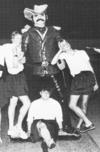|
Young kids are blameless in this kind of thing, victims of indoctrination. By the time we got old enough for high school a lot of us found the racist association embarassing. A year after I graduated the upper class voted to change the mascot and banish any symbols of the Confederacy. (Which may or may not have had anything to do with the school also hiring its first African American teacher.) It took another 14 years before they changed the name from “Rebels” entirely. I went to a great prep school and am thankful for the excellent education I got there. But only recently have I understood how white privilege helped gain me access to that education. SJS was not overtly racist or discriminatory. It just perpetuated (and still perpetuates) the advantages of whites. It is part of the legacy of one of the two Original Sins of America, the societal damage still extant six generations after the end of slavery. South Carolina’s use of the Confederate battle flag is controversial again this week. The defense that the flag symbolizes Southern Heritage is sincere, which is what makes endemic racism so dangerous. The Confederate flag represents the South’s pride in slavery, treason, and victimhood. That flag is a hateful thing, deliberately hateful. Here is a record of my visit to the Cooper Hewitt Museum in New York. There were 22 objects I liked enough to collect and I made 3 things myself. (Favorites: poster, staircase model.) I will be able to remember these things forever because of The Pen. The Pen is a new thing at the Cooper Hewitt. My buddy Aaron Straup Cope was one of its creators. It’s pretty simple to use. When you visit the museum they loan you a fancy digital pin, on a lanyard. You point it at the labels for objects you like. You can also use it to design things on big computer screen tables. When you’re done you can visit the website on your ticket any time to see your collection. Unlike 90% of fancy museum technologies, this one actually works. It's used a lot. It’s designed to keep working for many years. Aaron and his colaborator Seb Chan wrote a very long essay on the design of The Pen. It’s totally worth reading if you are interested in this kind of technology. But for the tl;dr crowd, a few key points.
The impressive thing to me is how simply all the tech worked without requiring you to understand or learn it. I wasn’t too excited about the design-your-own-objects part, but the tool for remembering the stuff I liked was excellent. I do wonder if there’s a simpler way to just build the collection product, something between this fancy three year project and simply adding some ugly QR-code stickers. Any new system designed for a museum will be well informed by The Pen.
I'm at the State of the Map conference.
Two different people here said "I like your blog!" on meeting me. It's so
nice to hear it! It's a nice compliment, and encouragement for the writing
I've done, and also establishes context for the following conversation.
It also felt terribly retro. The other half of that conversation was "Well it's been awhile.. I don't use RSS any more and with Twitter.." Yeah, I get it, personal blogs are a dying medium. I'm really on the fence about what to do with this blog. I want to keep it, but I don't post often. I set too high a bar for content quality so I don't post often. (See my secret work blog for what badly edited stuff looks like.) Also the design is depressingly outdated now, not to mention the software. Part of me wants to abandon it entirely but meeting people who like my blog keeps me motivated. |
||

